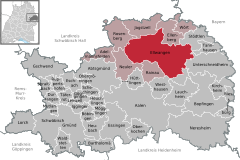
Aalen is a former Free Imperial City located in the eastern part of the German state of Baden-Württemberg, about 70 kilometres (43 mi) east of Stuttgart and 48 kilometres (30 mi) north of Ulm. It is the seat of the Ostalbkreis district and is its largest town. It is also the largest town in the Ostwürttemberg region. Since 1956, Aalen has had the status of Große Kreisstadt. It is noted for its many half-timbered houses constructed from the 16th century through the 18th century.

Franconia is a region of Germany, characterised by its culture and Franconian dialect.
The Ostalbkreis is a Landkreis (district) in the east of Baden-Württemberg, Germany, on the border to Bavaria. Neighboring districts are Schwäbisch Hall, Ansbach, Donau-Ries, Heidenheim, Göppingen and Rems-Murr.
Schwäbisch Hall is a Landkreis (district) in the northeast of Baden-Württemberg, Germany. Neighboring districts are Main-Tauber, the Bavarian district Ansbach, Ostalbkreis, Rems-Murr, and Hohenlohe.
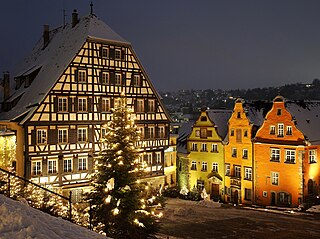
Schwäbisch Hall is a city in the German state of Baden-Württemberg located in the valley of the Kocher river, the longest tributary of the Neckar river. The closest larger city is Heilbronn, and Schwäbisch Hall lies north-east of the state capital of Stuttgart. It is the seat of the district (Landkreis) of Schwäbisch Hall.

The Jagst is a right tributary of the Neckar in northern Baden-Württemberg. It is 190 km long. Its source is in the hills east of Ellwangen, close to the Bavarian border. It winds through the towns Ellwangen, Crailsheim, Kirchberg an der Jagst, Langenburg, Krautheim, Möckmühl and Neudenau. Near Bad Wimpfen the Jagst flows into the Neckar, a few km downstream from the mouth of the river Kocher, that flows more or less parallel to the Jagst.

Öhringen is the largest town in Hohenlohe (district) in the state of Baden-Württemberg, in southwest Germany, near Heilbronn. Öhringen is on the railline to Schwäbisch Hall and Crailsheim.
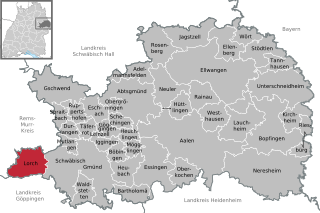
Lorch is a small town in the Ostalbkreis district, in Baden-Württemberg, Germany, by the river Rems, 8 kilometers west of Schwäbisch Gmünd. It is a part of the Ostwürttemberg region.
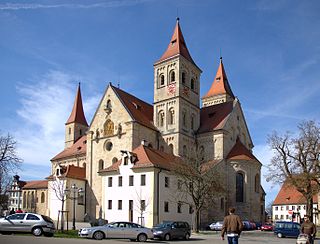
Ellwangen Abbey was the earliest Benedictine monastery established in the Duchy of Swabia, at the present-day town of Ellwangen an der Jagst, Baden-Württemberg, about 100 km (60 mi) north-east of Stuttgart.
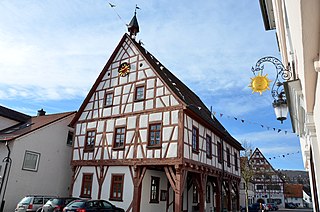
Schelklingen is a town in the district of Alb-Donau in Baden-Württemberg in Germany. It is situated 10 km north of Ehingen, and 20 km west of Ulm. Schelklingen and 82% of its territory form part of the Swabian Jura Biosphere Reserve.

Adelmannsfelden is a municipality in the German state of Baden-Württemberg, in Ostalbkreis district.

Tannhausen is a municipality in the German state of Baden-Württemberg, in Ostalbkreis district.

Prince-provost is a rare title for a monastic superior with the ecclesiastical style of provost who is also a Prince of the Holy Roman Empire (Reichsfürst), holding a direct vote in the Imperial Diet assembly coequal to an actual Prince-abbot, as in each case treated below.
Viktors Arājs was a Latvian/Baltic German collaborator and Nazi SS SD officer who took part in the Holocaust during the German occupation of Latvia and Belarus as the leader of the Arajs Kommando. The Arajs Kommando murdered about half of Latvia's Jews.
Rudolf Joachim Seck was an SS-Oberscharführer during World War II. During the war, Seck committed many atrocities for which he was later sentenced to serve life in prison by a West German court.
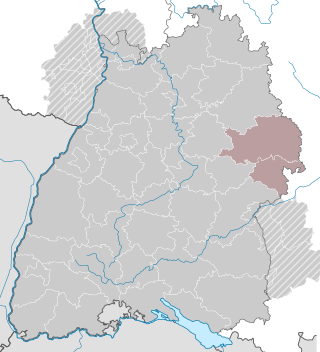
Ostwürttemberg is a region in eastern Baden-Württemberg, Germany, in the Stuttgart subdivision (Regierungsbezirk). It is located in the southwestern part of Germany. It consists of the districts of Heidenheim and Ostalb. It borders the Stuttgart Region to the west, the Heilbronn-Franken Region to the north, western Middle Franconia (Bavaria) to the east, Bavarian Swabia to the southeast, and the Alb-Danube district to the south.

The Swabian-Franconian Forest is a mainly forested, deeply incised upland region, 1,187 km² in area and up to 586.4 m above sea level (NHN), in the northeast of Baden-Württemberg. It forms natural region major unit number 108 within the Swabian Keuper-Lias Land. Its name is derived from the fact that, in medieval times, the border between the duchies of Franconia and Swabia ran through this forested region. In addition, the Swabian dialect in the south transitions to the East Franconian dialect in the north here.

The Virngrund is a historical landscape in the counties of Ostalbkreis and Schwäbisch Hall in the German state of Baden-Württemberg. it is forested in many places and up to 580 m above sea level (NHN).
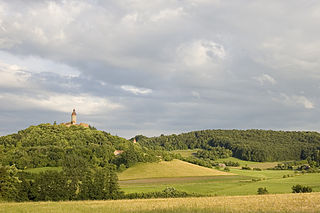
The Franconian Heights are a hill ridge, up to 554 m above sea level (NN), in Bavaria and Baden-Württemberg in South Germany.
Edith Raim is a German historian who studies the Nazi era. She grew up in Landsberg am Lech and first became interested in the topic after watching Holocaust as a child. Being a student of Anton Posset she started under his guidance the historical reappraisal of the concentration camp complex Kaufering, a sub-camp of Dachau concentration camp. Her 1991 dissertation at Ludwig Maximilian University of Munich was titled Die Dachauer KZ-Aussenkommandos Kaufering und Mühldorf: Rüstungsbauten und Zwangsarbeit im letzten Kriegsjahr 1944/45 and concerned the Dachau subcamps of Kaufering and Mühldorf.

